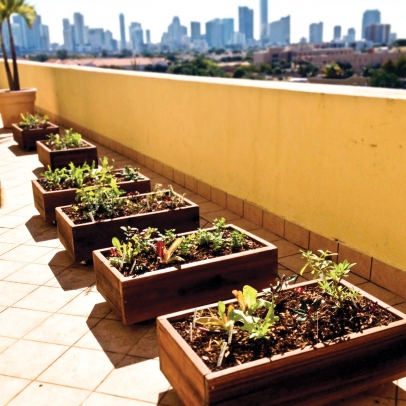Nearly Anyone Can Grow an Edible Garden, Anywhere
Small yard? Live in a condo? You, too, can try your hand at growing fruits and veggies at home, as long as you have the bare essentials. Just about anyone can grow an edible garden as long as you have three basics:
LIGHT – Your garden needs to get least four hours of direct light for herbs and greens, and at least eight hours of direct light for most vegetables and fruits. For a cool-weather garden in the winter, it’s particularly important to have sun exposure from the south. This means no obstructions (trees, tall hedges, walls, fences) blocking light directly south of the garden space. Generally, as long as the plants don’t dry out from thirst, the more light, the better for most edible plants.
GROWING MEDIUM – Unless you’re growing hydroponically, the gardener’s growing medium is generally soil and usually the source and storage of nutrients needed by plants.
WATER – Just like us, plants are composed of a large percentage of water. Just like us, they need to drink on a regular basis – some more than others.
If you have these three basic requirements, there are many different ways to grow food.
Condo terrace – Though it may not be feasible to produce a large amount of veggies due to space and wind, a condo terrace is a good place to grow culinary herbs in pots or small planters. In this setting, start with plants that are wind tolerant and somewhat drought tolerant, such as rosemary, oregano, thyme, sage and many other herbs. If your terrace has wind protection and ample room, you can also grow veggies and fruits. Often, terraces don’t have water connections, so you’ll need to bring water manually from inside in watering cans.
Porch – A patio or deck can work if there’s enough light and a convenient water source. If you’re putting pots or planters onto a wooden deck, minimize the amount of moisture on the bottom of the pots/planters to reduce rot. There are also planting containers that will hang on walls, railings and windowsills to have a garden without taking away from floor space.
Small backyard – Here you have more options because you can create planting areas directly on the ground and there might be space for fruit trees, too. If you’re growing on the ground in existing soil, you may need to add compost or well broken-down organic matter to add because South Florida’s soil is generally sandy, rocky and low in fertility on its own. See Composting 101 on page 20.
In a small backyard, plant taller plants like fruit trees on the north side of your space and lower growing plants on the south side. This helps maximize sun exposure. Plant frequently harvested salad greens and herbs closer to the kitchen.
Larger space – You can grow enough produce for a person or family if you plan and execute it well. You may even be able to grow enough to give away to friends and family and perhaps even sell. If you have a larger space, but little experience growing food, start with just a section and make sure it’s manageable before taking on the whole space. Create a design and plan for the garden for both the short term and long term.
Guerilla gardening – Though this might not follow the rules, there are plenty of plantable areas around in abandoned planters, vacant lots, swales and medians that can be viable garden sites. The major challenge will be watering.
Recycled planters – Planters can be made out of tires, milk jugs, shipping pallets, old trash cans, old recycling bins, scrap lumber, old buckets and kiddy pools. You can also get compost for free from the City of Miami composting facility on Virginia Key.
Dylan Terry is the owner of Ready-to-Grow Gardens, a local company that specializes in edible landscape design, installation and maintenance. Edible plants, seeds and other garden materials can be purchased at the Ready-to-Grow Garden Center on Saturdays noon-6, fall-spring, otherwise by appointment. For more information visit ready-to-grow.com. If you have any questions about edible gardening, email Dylan and he will answer them in our next issue.




